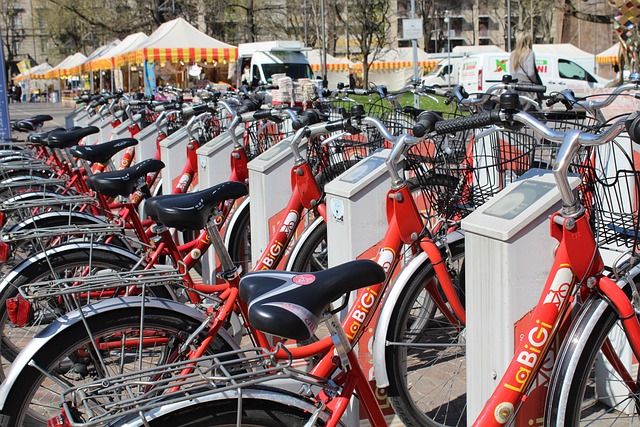The future of green vehicles is driven by an electric revolution and growing consumer demand for eco-conscious choices. Advances in battery tech, infrastructure expansion, biodegradable car waxes, sustainable materials, solar-powered chargers, community car-sharing, smart grid technologies, and sustainable manufacturing practices enable Select Sustainable Vehicles to transform urban transportation, reduce emissions, and create cleaner cities.
“The future of transportation is green, and the revolution is here. As we navigate an era of environmental awareness, the rise of select sustainable vehicles is a testament to our evolving mobility landscape. This article explores the three key pillars propelling this transformation: Electric Revolution, Sustainable Materials, and Smart Infrastructure. Discover how these innovations are not just shaping but redefining the way we travel, ensuring a cleaner, more efficient future for all.”
- Electric Revolution: Paving the Way Forward
- Sustainable Materials: Shaping the Next Generation
- Smart Infrastructure: Enabling Efficient Mobility
Electric Revolution: Paving the Way Forward

The future of green vehicles is here, led by an electric revolution that’s paving the way forward for a more sustainable transportation ecosystem. As consumers become increasingly aware of their environmental impact, there’s a growing demand for eco-conscious fleet vehicle choices, with electric and hybrid construction equipment leading the charge in the building industry. This shift towards sustainable transportation planning for urban development isn’t just about reducing emissions; it’s about reimagining mobility to create cleaner, greener cities.
The rise of electric vehicles (EVs) offers a promising solution to combat climate change. With advancements in battery technology and infrastructure expansion, EVs are becoming more affordable and accessible. Moreover, the integration of biodegradable car waxes and polishes further ensures that the entire lifecycle of these vehicles aligns with eco-building principles. This holistic approach to sustainable transportation not only reduces our carbon footprint but also contributes to a healthier environment for future generations.
Sustainable Materials: Shaping the Next Generation

The future of green vehicles is closely tied to the innovative use of sustainable materials. As the market for Select Sustainable Vehicles continues to grow, manufacturers are increasingly turning to eco-friendly alternatives to traditional automotive components. This shift not only reduces a vehicle’s environmental impact but also opens up exciting possibilities for design and functionality. From lightweight, durable materials like recycled plastic and carbon fiber composites to advanced textiles made from plant-based fibers, these sustainable options are transforming the automobile industry.
By integrating solar-powered chargers for electric vehicles and promoting the use of electric bikes for last-mile delivery, manufacturers can further enhance the eco-credentials of their products. Additionally, the availability of ecological vehicle insurance options encourages responsible ownership while making green vehicles more accessible to a wider range of consumers. Even budget repairs are made more feasible with the emergence of recycled automotive parts, ensuring that sustainability doesn’t have to come at the expense of affordability. Community-based car-sharing initiatives further contribute to this movement by reducing overall vehicle ownership and minimizing the environmental footprint associated with personal transportation.
Smart Infrastructure: Enabling Efficient Mobility

The future of green vehicles is closely tied to the evolution of smart infrastructure, which plays a pivotal role in enabling efficient and sustainable mobility. As we transition towards a greener transportation landscape, cities are adopting innovative strategies to support the growing demand for eco-friendly options. Smart grid technologies, integrated with renewable energy sources like solar power, offer a promising solution for charging infrastructure, especially for electric vehicles (EVs). This ensures a reliable and environmentally conscious charging network, even in off-grid living situations, with solar-powered vehicles leading the way.
Furthermore, sustainable automotive manufacturing practices and green logistics centers are set to streamline the supply chain, making deliveries more efficient and reducing carbon emissions. Carbon capture technologies will also play a significant role in capturing and utilizing vehicle exhaust emissions, contributing to a cleaner environment. By combining these elements, we can expect a seamless transition towards a future where sustainable vehicles are not just an option but the norm, redefining urban mobility and promoting a greener planet.
As we look towards the future, it’s evident that green vehicles are not just a trend but an essential component of sustainable mobility. With advancements in technology and increasing consumer demand, the electric revolution is gaining momentum. By adopting sustainable materials and developing smart infrastructure, we can create an efficient and eco-friendly transportation network. Embracing these changes will not only benefit the environment but also drive innovation, making green vehicles a practical and desirable choice for everyone. Selecting sustainable vehicles today paves the way for a greener tomorrow, ensuring a more livable and resilient world for future generations.



